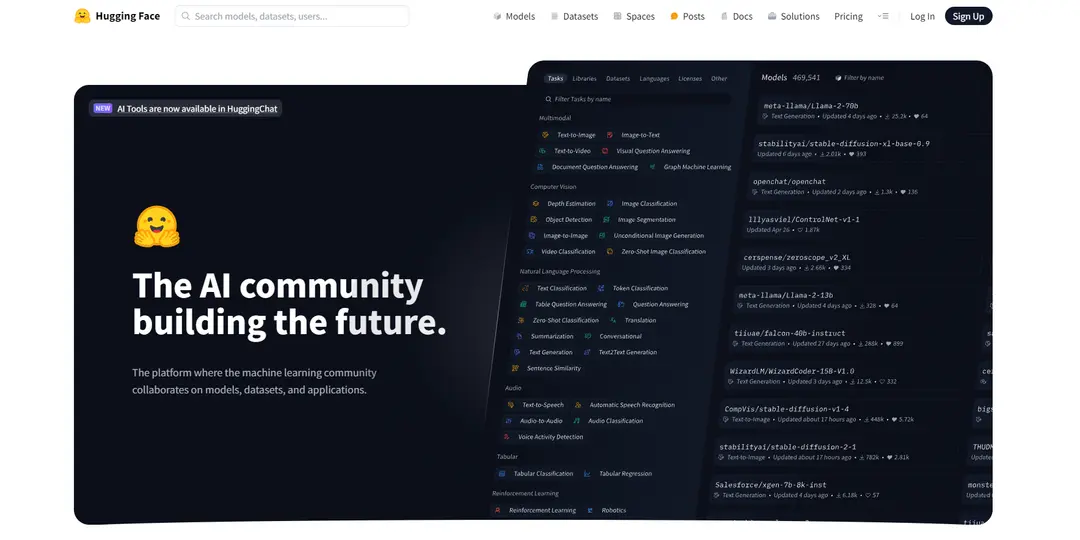Hugging Face
Hugging Face is an open-source platform and community that democratizes artificial intelligence through collaborative development of machine learning models, datasets, and applications.
https://huggingface.co/

Product Information
Updated:Nov 16, 2025
What is Hugging Face
Hugging Face is a leading AI company that provides a comprehensive ecosystem for machine learning, particularly in natural language processing (NLP). Founded in 2016, it has evolved from a chatbot developer to become the hub of the AI community, offering tools, libraries, and a collaborative platform for researchers and developers. At its core is the Hugging Face Hub, which hosts thousands of pre-trained models, datasets, and machine learning applications that are freely accessible to the public.
Key Features of Hugging Face
Hugging Face is an open-source platform and community for machine learning, offering a wide range of tools, models, and datasets. It provides a collaborative environment for developers to create, share, and deploy AI models, particularly in natural language processing. The platform includes features like model hosting, dataset management, and easy-to-use APIs, making it a comprehensive ecosystem for AI development and deployment.
Model Hub: A vast repository of pre-trained models for various AI tasks, allowing users to easily find, use, and share machine learning models.
Datasets Library: A collection of over 30,000 datasets for training and evaluating AI models across different domains and modalities.
Transformers Library: An open-source library providing state-of-the-art machine learning models, particularly for natural language processing tasks.
Spaces: A platform for creating and sharing interactive machine learning demos and applications.
AutoNLP: A tool for automating the process of training and deploying custom NLP models without writing code.
Use Cases of Hugging Face
Natural Language Processing: Develop and deploy models for tasks like translation, summarization, and text generation in various industries.
Computer Vision: Create and use models for image classification, object detection, and image generation in fields like healthcare and autonomous vehicles.
Audio Processing: Build and implement models for speech recognition, audio classification, and text-to-speech applications in customer service and entertainment.
Research and Development: Collaborate on cutting-edge AI research, share findings, and access state-of-the-art models and datasets.
Pros
Large and active open-source community
Comprehensive ecosystem of tools and libraries
Easy-to-use interfaces for both beginners and experts
Cons
Potential for biased models if not carefully vetted
Learning curve for utilizing all features effectively
How to Use Hugging Face
Create a Hugging Face account: Go to the Hugging Face website (huggingface.co) and sign up for a free account to access the platform's features.
Install required libraries: Use pip to install the necessary Hugging Face libraries, including transformers, datasets, and tokenizers.
Explore pre-trained models: Browse the Hugging Face Model Hub to find pre-trained models suitable for your task, such as text classification, named entity recognition, or language generation.
Load a pre-trained model: Use the Transformers library to load a pre-trained model and its associated tokenizer using the AutoModel and AutoTokenizer classes.
Preprocess your data: Prepare your input data by tokenizing it using the model's tokenizer to convert text into a format the model can understand.
Perform inference: Use the loaded model to make predictions on your preprocessed data, such as generating text or classifying input.
Fine-tune the model (optional): If needed, fine-tune the pre-trained model on your specific dataset using the Trainer class from the Transformers library.
Save and share your model: Save your fine-tuned model and push it to the Hugging Face Hub to share it with the community or use it in your projects.
Create a demo (optional): Use Hugging Face Spaces to create an interactive demo of your model, allowing others to easily test and use it.
Collaborate and explore: Engage with the Hugging Face community by exploring other models, datasets, and demos, and contributing to open-source projects.
Hugging Face FAQs
Hugging Face is an open-source platform for machine learning and artificial intelligence. It provides tools, libraries, and a collaborative community for developing, sharing, and using AI models, particularly in natural language processing.
Official Posts
Loading...Related Articles
Popular Articles

AI Christmas Photo Trend 2025: Viral Prompts, Free Generators & How to Create Stunning Christmas AI Photos
Dec 23, 2025

ChatGPT Image 1.5 vs Nano Banana Pro: The Battle for the Best AI Image Generator in 2025
Dec 18, 2025

ChatGPT Image 1.5 Is Here: Inside OpenAI’s New AI Image Generation Model in 2025
Dec 18, 2025

OpenAI GPT-5.2 vs Google Gemini 3 Pro: Latest Review 2025
Dec 18, 2025











